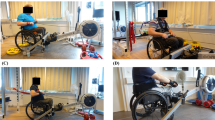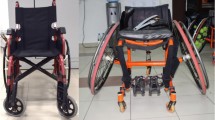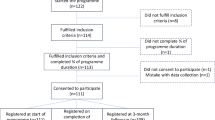Abstract
Study design:
Each participant performed a series of wheelchair exercises equivalent in intensity to minimal functional speed (1 m s−1), functional walking speed (1.3 m s−1), a relatively challenging speed (1.6 m s−1) and a self-selected speed. Each participant also completed a graded exercise test (GXT) to volitional exhaustion (VO2peak).
Objectives:
The purpose of this study was (1) to assess the physical capacity of wheelchair users as they undertake typical mobility activities and (2) to investigate how closely the components of a differentiated model of perceived exertion mirror wheelchair users' own perception of exertion.
Methods:
Eleven (eight males and three females) spinal cord-injured or congenitally impaired wheelchair-dependent participants volunteered for the study. Differentiated ratings of perceived exertion (RPE_arm and RPE_respiration) and oxygen uptake (VO2) and heart rate were recorded during each exercise.
Results:
The mean comfortable speed at which the participants propelled their own wheelchairs on the wheelchair ergometer was 1.1±0.2 m s−1. Speeds of 1 m s−1 and 1.3 m s−1 are typical of everyday functional propulsion. The corresponding RPE_respiration and RPE_arm ranged from 7 to 13 on the Borg scale; the %VO2peak measured in these trials ranged from 37 to 80% VO2peak. For propulsion intensities used in the present study—low, moderate, high and graded exercise intensity—no difference could be observed between RPE_respiration and RPE_arm. There were no significant differences between RPE_arm and RPE_respiration at the termination of the GXT.
Conclusion:
The current study showed potential for the use of RPE to assess and monitor daily wheelchair propulsion intensity in individuals with paraplegia.
Similar content being viewed by others
Log in or create a free account to read this content
Gain free access to this article, as well as selected content from this journal and more on nature.com
or
References
van der Woude LH, de Groot S, Janssen TW . Manual wheelchairs: research and innovation in rehabilitation, sports, daily life and health. Med Eng Phys 2006; 28: 905–915.
Bauman WA, Spungen AM . Coronary heart disease in individuals with spinal cord injury: assessment of risk factors. Spinal Cord 2008; 46: 466–476.
Bauman WA, Spungen AM . Carbohydrate and lipid metabolism in chronic spinal cord injury. J Spinal Cord Med 2001; 24: 266–277.
Jacobs PL, Nash MS . Exercise recommendations for individuals with spinal cord injury. Sports Med 2004; 34: 727–751.
Devillard X, Rimaud D, Roche F, Calmels P . Effects of training programs for spinal cord injury. Ann Readapt Med Phys 2007; 50: 480–498.
Eston RG, Williams JG . Reliability of ratings of perceived effort regulation of exercise intensity. Br J Sports Med 1988; 22: 153–155.
Al-Rahamneh HQ, Eston RG . Prediction of peak oxygen consumption from the ratings of perceived exertion during a graded exercise test and ramp exercise test in able-bodied participants and paraplegic persons. Arch Phys Med Rehabil 2011; 92: 277–283.
Lenton JP, Fowler NE, van der Woude L, Goosey-Tolfrey VL . Wheelchair propulsion: effects of experience and push strategy on efficiency and perceived exertion. Appl Physiol Nutr Metab 2008; 33: 870–879.
Goosey-Tolfrey VL, Alfano H, Fowler N . The influence of crank length and cadence on mechanical efficiency in hand cycling. Eur J Appl Physiol 2008; 102: 189–194.
Al-Rahamneh H, Eston R . Rating of perceived exertion during two different constant-load exercise intensities during arm cranking in paraplegic and able-bodied participants. Eur J Appl Physiol 2010; 111: 1055–1062.
Goosey-Tolfrey VL, Lenton J, Goddard J, Oldfield V, Tolfrey K, Eston R . Regulating intensity using perceived exertion in spinal cord-injured participants. Med Sci Sports Exerc 2010; 42: 608–613.
Goss F, Robertson R, DaSilva S, Suminski R, Kang J, Metz K . Ratings of perceived exertion and energy expenditure during light to moderate activity. Percept Mot Skills 2003; 96: 739–747.
Haisma JA, van der Woude LH, Stam HJ, Bergen MP, Sluis TA, Bussmann JB . Physical capacity in wheelchair-dependent persons with a spinal cord injury: a critical review of the literature. Spinal Cord 2006; 44: 642–652.
Paulson TA, Bishop NC, Eston RG, Goosey-Tolfrey VL . Differentiated perceived exertion and self-regulated wheelchair exercise. Arch Phys Med Rehabil 2013; 94: 2269–2276.
Faulkner J, Eston R . Overall and peripheral ratings of perceived exertion during a graded exercise test to volitional exhaustion in individuals of high and low fitness. Eur J Appl Physiol 2007; 101: 613–620.
Bolgar MR, Baker CE, Goss FL, Nagle E, Robertson RJ . Effect of exercise intensity on differentiated and undifferentiated ratings of perceived exertion during cycle and treadmill exercise in recreationally active and trained women. J Sports Sci Med 2010; 9: 557–563.
Robertson RJ, Noble BJ . Perception of physical exertion: methods, mediators, and applications. Exerc Sport Sci Rev 1997; 25: 407–452.
Rimaud D, Calmels P, Devillard X . Training programs in spinal co rd injury. Ann Readapt Med Phys 2005; 48: 259–269.
American College of Sports Medicine. ACSM's Guidelines for Exercise Testing and Prescription. Williams & Wilkins: Philadephia, PA, USA. 2010.
Cowan RE, Nash MS, Collinger JL, Koontz AM, Boninger ML . Impact of surface type, wheelchair weight, and axle position on wheelchair propulsion by novice older adults. Arch Phys Med Rehabil 2009; 90: 1076–1083.
Acknowledgements
This project was funded by Alberta Paraplegia Foundation (grant award number: 19582/74) in collaboration with Rick Hansen Foundation. We thank Frank Geddes and Pamela Bentley for assistance with recruitment of participants. We thank all the participants for participating and giving feedback. We thank Jiajie Wu for assistance with data collection and Farhood Mohammadi for support with statistical analysis and Vicky Tolfrey, Loughborough University, UK, for proposing the original study design. Reprint requests to Martin Ferguson-Pell, South Academic Building, University of Alberta, Edmonton, Alberta, Canada T6G 2G7.
Author information
Authors and Affiliations
Corresponding author
Ethics declarations
Competing interests
The authors declare no conflict of interest.
Rights and permissions
About this article
Cite this article
Qi, L., Ferguson-Pell, M., Salimi, Z. et al. Wheelchair users' perceived exertion during typical mobility activities. Spinal Cord 53, 687–691 (2015). https://doi.org/10.1038/sc.2015.30
Received:
Revised:
Accepted:
Published:
Issue date:
DOI: https://doi.org/10.1038/sc.2015.30



